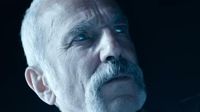Eight years after Daniel Day-Lewis stunned the film world with his abrupt retirement, the legendary actor has returned to the screen in an unexpected and deeply personal project. Anemone, which premiered at the New York Film Festival and opens in theaters on October 3, 2025, marks not only Day-Lewis’s comeback but also the directorial debut of his son, Ronan Day-Lewis. The film, co-written by the father-son duo, is a meditation on family, isolation, and the sometimes-painful bonds that tie us together.
For those who have followed Day-Lewis’s career, his absence has been palpable. After winning three Best Actor Oscars and delivering performances that have become benchmarks of cinematic excellence, Day-Lewis stepped away from acting following 2017’s Phantom Thread. According to the Associated Press, he explained at the time that he wanted to “explore the world in a different way.” Yet, as he now admits, that decision was less a definitive break than a pause—a chance to reflect, recharge, and, as it turns out, eventually collaborate with family.
Speaking alongside Ronan in a recent interview, Day-Lewis acknowledged, “It saddened me that I had perhaps ruled myself out of that when I decided to work on something else for a while. As we progressed through it, and it seemed less and less possible to contain it, like two fellas in a shed, it began to alarm me slightly. I understood that this was going to involve the full paraphernalia of a film production, and that wasn’t something I was eager to get back into. But we just kept moving forward to see what would happen. And this is what happened.”
Anemone is a quiet, sometimes glacially paced film, but it’s visually stunning and deeply atmospheric. The story centers on Ray Stoker (played by Day-Lewis), a hermit who has withdrawn from society to live in a remote cabin. His brother Jem (Sean Bean) embarks on a journey—navigating by hidden GPS coordinates—to find Ray and bring him back to the fractured family he left behind. The film’s opening is almost wordless, as Jem says goodbye to his wife Nessa (Samantha Morton) and son Brian (Samuel Bottomley), then sets off into the lush, stormy woods captured so hauntingly by cinematographer Ben Fordesman.
As reported by Collider, Ronan Day-Lewis’s direction is marked by a painterly eye—perhaps not surprising, given his background as a visual artist. The camera lingers on the dark skies and the thick green of the forest, creating a sense of isolation that mirrors Ray’s emotional state. In one particularly memorable sequence, the film pulls back from the brothers’ cabin, the wall detaching as Ray and Jem dance inside, before drifting through the woods. The score by Bobby Krlic, known for his work on Midsommar and Beef, adds another layer of tension and melancholy, with sweeping, haunting music that underscores the film’s moodiness.
Despite the film’s visual and auditory beauty, Anemone has divided critics. Some have praised the film’s immersive atmosphere and Day-Lewis’s magnetic presence, while others have found its pacing and sparse narrative frustrating. Collider notes that “Anemone is a mostly reserved story, and especially as it gets started, it remains almost completely free of dialogue.” The film’s slow build is punctuated by two monologues delivered by Day-Lewis—moments that serve as emotional anchors and showcase the actor’s undiminished power. The first, darkly humorous yet tinged with pain, provides a disturbing revelation about Ray’s past, while the second is described as the film’s emotional high point, with Day-Lewis allowing Ray’s carefully constructed defenses to crumble.
In the words of Day-Lewis, “You hope to create a world, an illusion. And when somebody says to you, ‘That was the last shot. Go home now,’ that was so bewildering to me because I’m still invested in that world. It’s not I have trouble letting go of it. The trouble I have is that I want to still splash around in that illusion.” This immersion in character—often labeled as Method acting—has long been the subject of fascination and sometimes misunderstanding. Day-Lewis pushes back against the idea that his approach is masochistic or self-destructive, saying, “The work itself was always nourishing to me.”
Ronan Day-Lewis, for his part, grew up observing his father’s process from afar, visiting sets but never fully understanding the depth of his preparation. “It always held a huge amount of mystery to me what he was doing,” Ronan recalls. Making Anemone together was, for both, a leap into the unknown. The project began as a small, almost private experiment, but grew into a full-fledged feature—one that, for Daniel, included his first screenwriting credit. “That’s a completely new experience for me,” he says. “I never really dared attempt to write before, so it’s a new thing. You can begin with absolutely nothing and the hunger can grow out of that.”
Yet, as visually striking as Anemone is, some critics have found its narrative lacking. According to Collider, the film “seems to think that having languid, hushed moments over and over again for the majority of the film equates to depth. Instead, this is a half-considered narrative about fathers, sons, and brothers, trauma, PTSD, and more, that doesn’t really have anything all that important to say.” Characters other than Ray are described as underdeveloped, with Jem, Nessa, and Brian left mostly to wait and worry in gloomy English suburbs. The film’s slow pace and minimal action have led some to suggest that its story would have been better suited to a short film rather than a feature-length production.
Still, there’s no denying the impact of Day-Lewis’s performance when the script gives him room to work. His portrayal of Ray Stoker is both vulnerable and enigmatic, a man haunted by his past yet unable to fully explain or escape it. The scenes between Ray and Jem, though sparse in dialogue, are loaded with unspoken tension and years of pain. Day-Lewis’s physicality—the way he moves through the cabin, his interactions with the world he’s built for himself (right down to the expired sardine cans lining the shelves)—brings Ray to life in a way that only an actor of his caliber could achieve.
For Day-Lewis, the return to acting was less a triumphant comeback than a natural outgrowth of his ongoing need to express himself. “It has been my primary form of self-expression for my entire life, since I was a child,” he says. “And therefore, I don’t know if I experience it as a sense of missing if I’m not doing it. But the need to express myself in that way, even at a subterranean level, that is still there.”
Whether Anemone will be seen as a successful experiment or a beautiful misfire remains to be seen. But for Daniel and Ronan Day-Lewis, it stands as a testament to the power of family, creativity, and the enduring pull of storytelling—even when the world, and the artist, tries to walk away.



